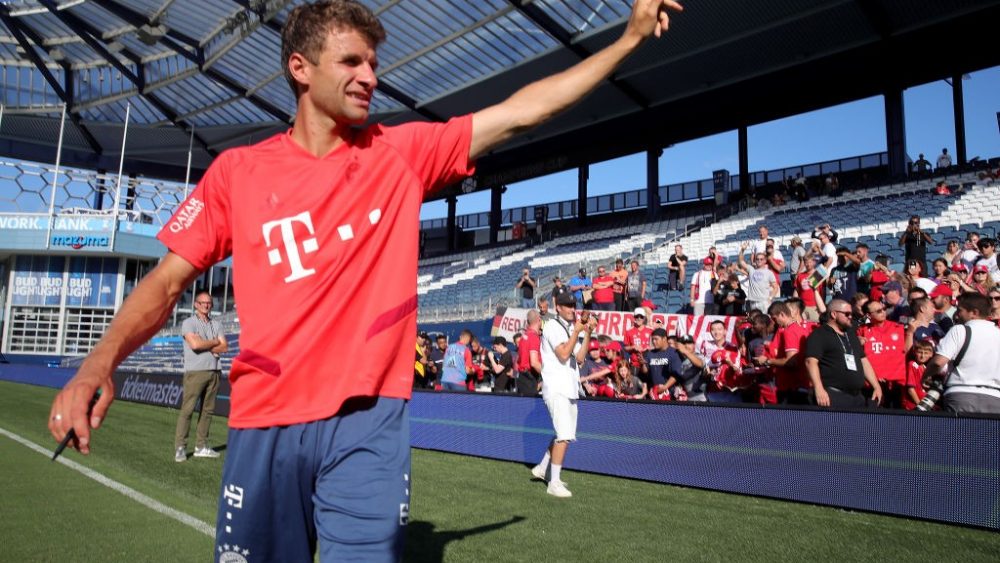“The sporting value played second fiddle to the marketing value”
Specifically, we wanted to talk to Jonas about all aspects of this tour. His work as a journalist, the sporting value of a tour like this, and the commercial incentives behind a trip to the other side of the world.
The US tour as a journalist
Hi Jonas, you had the opportunity to join the club on their US tour as a journalist for the first time. How many of you journalists participated in the tour in all?
There were ten of us – print, online, TV, and video, plus two photographers.
Let’s talk about the general program of the tour. Who was responsible for making all the necessary arrangements for you journalists before the start of the tour? Is everything prepared for you from transport to accommodation?
When we journalists accept the offer by the club to join their tour, everything is organised to a T, from the departure in Munich to our return ten days later. We know in advance all our hotels and we have a special bus with local guides to take us to all official events during the tour. We travelled to the US and inside the country on the same flights as the Bayern team and management. This was a major advantage especially within the US as we could proceed directly to the runway and undergo our security checks there.
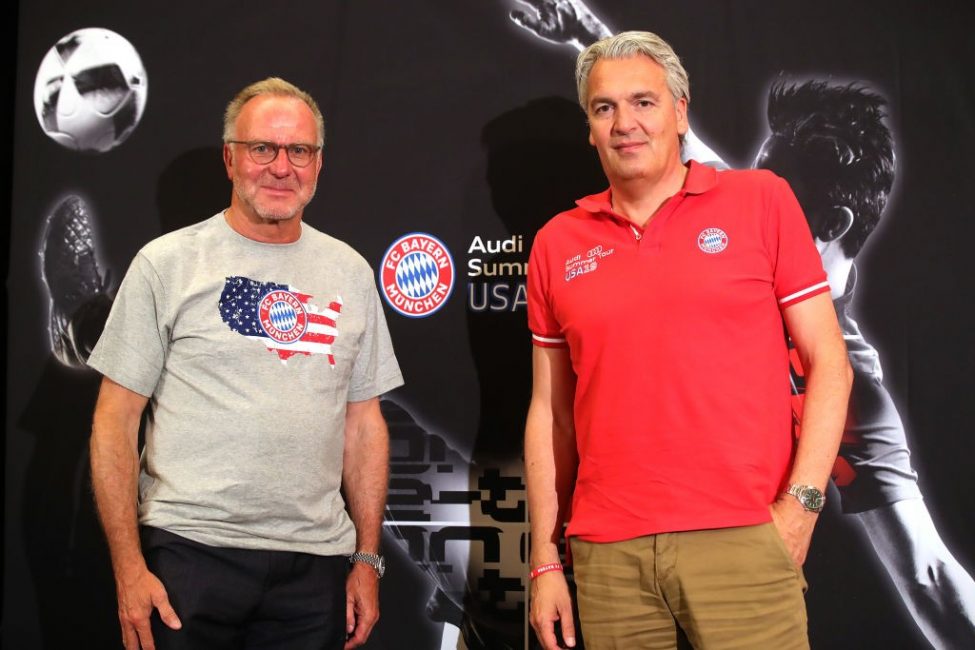
(Photo: Alexander Hassenstein/Bongarts/Getty Images)
The downright highlight in this regard was a police escort in Houston that cleared the road for us until our bus lost contact to the main group. By the way, our colleagues from the Kicker and dpa planned and took the tour completely by themselves without being excluded or barred from any official FC Bayern events. So that was absolutely possible too.
What was the role of the FC Bayern office in New York in the preparations?
As far as us media is concerned, I could not say for sure because the tour, like the official Champions League press trips, was organised by FC Bayern Tours. But generally speaking the New York office was the main responsible party for the US tour. Over 100 of their people worked in the background on organising the tour at times.
A beer to end the work day with the club officials at the hotel bar, lying in wait for players returning from bars and clubs. These are the stories about the good old days. Did stuff like this really ever happen and how accessible actually is a club like FC Bayern on a tour like this today?
The FC Bayern communications department has been making a notable effort to establish a friendly relationship with the media ever since their catastrophic press conference in October 2018 – this is apparent especially during official tours.
On the first evening the club invited us to a small welcome talk with Karl-Heinz Rummenigge, Jörg Wacker, and other management officials in the team hotel. There we actually did have an end-of-day-beer and some interesting quotes from Karl-Heinz Rummenige and others on top.
“The list of all of the club’s dates and appointments in the US was quite something to behold. It had everything: national and international media obligations, sponsorship events, and fan clubs.”Jonas Austermann, about the players’ media commitments during the tour
On the last night in Los Angeles the club granted us access to the „Audi Player Night“ on the condition that we would not do any research for an article or TV show. Besides a lot of invited guests, the whole team was present. Some of the players even stopped by for a brief word or two with us media representatives. Except for this night, the players did not have a whole lot of time to visit bars or clubs as far as I know.
But I think that times have changed anyway in this regard. Nobody can afford any more to find themselves in the newspapers after a drunken night out. Pictures of this would appear on the net sooner or later anyway, even if no journalist was present.
Traditionally, FC Bayern always organises a night out for the media on all of their trips, whether it is a Champions League match or a tour of the US. Such evenings help a great deal to get to know the people at FC Bayern better and learn something about their views on certain issues or what they read in the press.
Is there still the opportunity left at all to talk to people individually in an interview or in private off the record?
This is becoming more and more difficult, which makes it all the more important for me as a tabloid reporter. And yes, such opportunities still exist. In the US, for example, I had the chance to talk to Karl-Heinz Rummenige about the problem of the first team season tickets not allowing attendance of the second team matches any more. I had also requested an interview with Leon Goretzka before the tour, which the Bayern communications department granted me for after their training in Kansas City.
The same as after every Bundesliga match, the mixed zone gives us the chance to talk with a player individually about a certain topic. This is when your positional play and observational skills as a journalist are needed. It also helps if the players know you from sight or if you have talked to them before.
How big do you think is a player’s relative share of traditional media work – interviews with the press, appearances at press conferences and so on – compared to what they do for the club or for self-promotion – shooting commercials, visiting children’s homes, signing autographs etc.?
The players still spend most of their time on traditional media work, but the time they spend on sponsorship obligations or shooting videos for the club has been increasing steadily in the last years, gradually eating away at their free time too.
“I quite liked the matches against Arsenal and Real. They had quite a decent tempo to them. Generally speaking, I think that the Bayern players will benefit from a summer without international competitions.”Jonas Austermann, about the football perspective on the US tour
The list of all of the club’s dates and appointments in the US was quite something to behold. It had everything: national and international media obligations, sponsorship events, and fan clubs – add to that ten hard training sessions. The sponsorship events are of value to us journalists too because they usually finish with a small media conference and sometimes we can even talk to a player one on one.
What is the added value of a newspaper like tz for a fan considering that players and clubs have their own media outlets and can talk directly to their fans and all the world 24/7 through their own channels?
Players and clubs present themselves the way they want to be seen. It is upon us journalists to find out and publish the things they want to keep under lock and key. The truth is sometimes inconvenient.
The press also has to put an isolated news item into a broader perspective and provide the reader with some context. They should not be left stranded with a random piece of information. In tabloid journalism a player’s personal social media account is a very important resource. We could even add something of value to a muscle photo of Robert Lewandowski – for example talk to an athletics coach about Lewandowski’s training regime.
What does the schedule of a reporter look like on such a tour? Being present at games and training, writing articles, and having phone calls with the editors at home?
Thanks to the time difference between Germany and the US, I had enough time to attend all official club dates and get a feeling of the situation myself without being constantly interrupted. So although I am a print journalist I did not have to write something all the time. The downside was that I had to stay up until 2 or 3 o’clock each morning. Usually, I had already agreed on the topics and length of my articles with my editor the night before. Because I did not want to lose most of my day in the US to sleeping, I only slept for 6 or 7 hours most nights. I really started to feel that after a week.
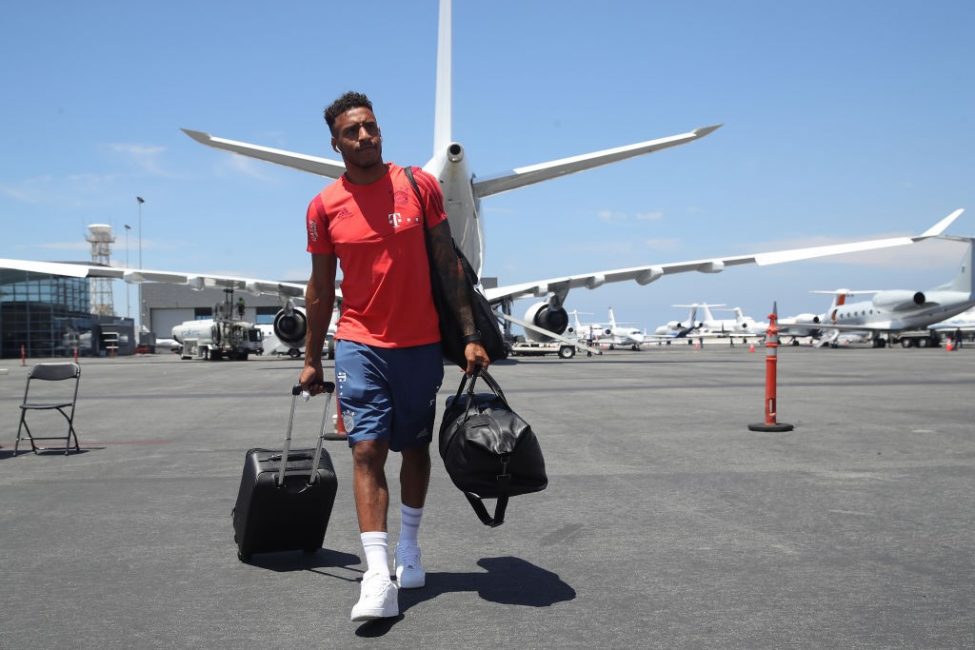
(Photo: Alexander Hassenstein/Bongarts/Getty Images)
A colleague of yours once said about a training camp in Qatar he attended that he felt like a “one man content machine”: producing videos, recording podcasts, filling social media, and, oh yes, by the way, writing of articles. How was this for you? What kind of hardware and software did you have to know for this trip?
I only needed my two smartphones (private and business) and my laptop. The tz keeps print and online strictly separate. That’s why I only had to write articles. I have a private Twitter account, but that does not have priority. I only write on there every now and then when I have time.
Did you have a specific allotment of articles for the tour that you had to publish each day or in a week?
There was no fixed number but I filed between three and five texts of different length each day. The colleagues in Munich turned that into approximately two newspaper pages every day. For perspective: that is about 8.000 characters. Additionally, I had to have some previously prepared stories available for slow news days, for example transit days or when nothing much happened – like my interview with MLS champion Julian Gressel is an example.
Was there any time left for you to privately explore the cities at all? Los Angeles, Houston, Kansas City – that sounds tempting for a tourist.
In Los Angeles we were lucky enough to have a day almost without any official commitments all to ourselves. Two colleagues and I took this opportunity and we went to Santa Monica Pier, rented an E-bike there and continued to Venice Beach. Houston was less tempting – at least the area where our hotel was. Kansas City, on the other hand, was very green and less crowded than the other two cities, I quite liked that. En route to the club’s official events, our local guides also often told us something about the respective cities.
The US tour as season preparation
Let us take a look at the team now. What was your impression of the team’s level of performance in the US?
I quite liked the matches against Arsenal and Real. They had quite a decent tempo to them. In the third match against Milan, you could feel that the team was set to return to Germany immediately after the blow of the final whistle. Generally speaking, I think that the Bayern players will benefit from a summer without international competitions. All key players should be at the same level of fitness, except for €80m transfer Lucas Hernández.
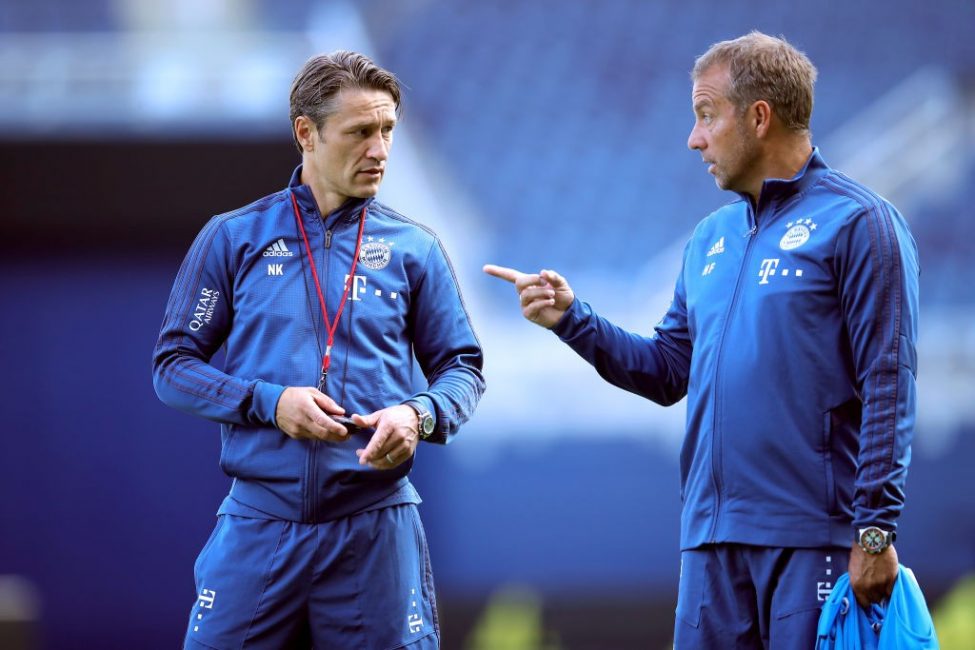
(Photo: Alexander Hassenstein/Bongarts/Getty Images)
You have already touched on Bayern’s three matches. They managed two out of three wins against such notable opposition as FC Arsenal, Real Madrid, and AC Milan. Maybe you could talk about each match in a little bit more detail? What were your respective feelings leaving the stadia?
In the match against Arsenal, Bayern appeared fragile at the back, particularly in the second half. They made a lot of simple mistakes. On attack, the performance was quite pleasing in all three matches. The resounding victory against Real was especially satisfying to players and coaching team alike. Even though it was just a test match, you could feel that it was a huge boost to their self-confidence. Against Milan some key players were missing (Gnabry, Martínez, Lewandowski) and yet Bayern managed a comfortable victory. I was actually startled to see what had become of the once so mighty AC Milan in that match.
A lot has been said about new assistant coach Hansi Flick in the last few days. What was his role in training and in the instruction of the players? Is there a difference in how they fill the assistant coach role between him and his predecessor last season?
Flick was very present at the training sessions we had access to. He often called players over for quick one on one talks and made jokes. He also frequently praised players – Renato Sanches in particular. It seemed as if he related really well to all the players. He routinely took control of training elements as well and gave instructions. On the whole, he seems to be a bit more vocal and straightforward than his predecessor Peter Hermann.
Which players do you consider the winners of this tour and why?
Renato Sanches and Thiago. Sanches reportedly was willing to leave the club before the tour, but in a conversation with Karl-Heinz Rummenigge over a cup of coffee he committed to giving it one more try. And in the matches against Real and Milan, he turned his words into action. He is a unique kind of player in midfield in my opinion. If he is able to use his solo runs and his strengths in duels effectively this season, he may finally be able to deliver on all his great promise.
Thiago was a very dominant presence and extremely reliable as the single holding midfielder in a 4-3-3. As soon as he was out, Bayern turned from a stronghold into a house of cards in defence. The tour has underscored his pivotal importance in defensive midfield once again.
The US tour as a marketing tool
How would you assess the US tour on the whole: how important was the sporting aspect of it compared to the marketing aspect?
The sporting value clearly played second fiddle to the marketing value. But the three test match opponents were decent and Niko Kovač had very favourable training conditions everywhere. That all the flying around took its toll goes without saying. We journalists felt this strain too.
How important was the tour from a marketing standpoint for FC Bayern in your opinion? Did it really serve to strengthen the club’s reputation or win any new supporters in the US?
That is very hard for me to say. Without a doubt there were a lot of Bayern and Germany fans at every stadium we went. In Los Angeles and Houston the red shirts were in the minority. But I think that by its presence alone the club could win a few new fans. I want to praise the club specifically for the political message they sent by opening the travelling exhibition “Venerated – Persecuted – Forgotten” in the Los Angeles Museum of the Holocaust.
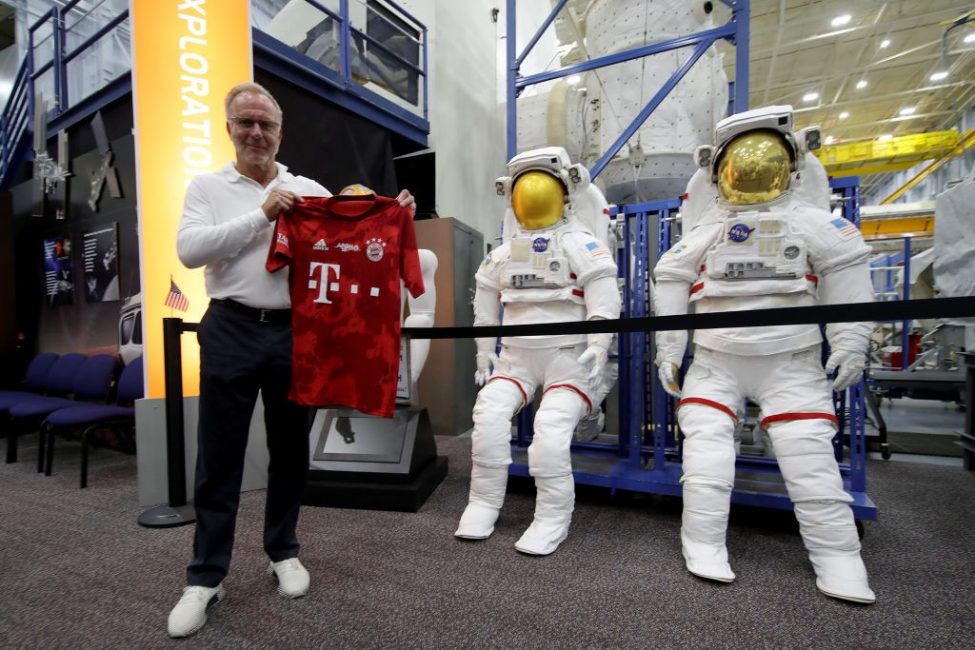
(Photo: Alexander Hassenstein/Bongarts/Getty Images)
As far as the marketing value is concerned, are journeys like this still worth the effort in times of Instagram, Facebook, and Twitter, as well as globally available online club TV, or should all this money and effort rather be put elsewhere, the next transfer for example?
I do believe that the club – if it wants to conquer the American and Chinese markets – has to physically be there in these countries. Instagram, Facebook, and Twitter alone will not be enough to overtake the clubs from the Premier League. For this to happen, the people at the club will have to show up on location as real people to touch and shake hands with – current players, legends, and bosses alike.
I do not not know the actual figures for Bayern, but other clubs have made money from such trips. I could well imagine that Bayern has returned home with a few more dollars in their pockets then they had before lift-off in Munich. And even if there has not been any immediate financial gain, the tour will pay off in the long run.
Karl-Heinz Rummenigge spoke of an all around satisfying journey to the US. Many a news report remarked that FC Bayern was unusually approachable and accessible at all levels over there. This is what a lot of fans miss at home. Your view: would it be good advice for FC Bayern to implement its international marketing strategy with its ‘close up and personal‘ style here in Germany too?
Manuel Bonke, a colleague of mine, and I had an interview with Jörg Wacker, Bayern VP for internationalisation and strategy. In this interview, we asked him exactly this very question. He pointed out that Bayern did in fact travel all over Germany, maybe even Europe, 355 days a year. Just next week for example there is the customary training camp at the Tegernsee, where the club is always very close and open to the fans and holds a lot of public training sessions – even if considerably fewer than last year.
“I want to praise the club specifically for the political message they sent by opening the travelling exhibition “Venerated – Persecuted – Forgotten” in the Los Angeles Museum of the Holocaust.”Jonas Austermann, about FC Bayern using their public recognition for a good cause
Jörg Wacker also said: “our fans in Shanghai and New York are just as much our fans as those in Pasing.” This may be hard to swallow for some people but it probably is the only realistic mindset to have if the club wants to keep up with the big boys, especially financially.
Most of the Bayern matches in the US were sold out. How different is the average American football fan to the German one, what was the general reception of FC Bayern over there, and which player did the Americans like best?
In the US, many fans arrive just in time for kick off and many like to get up and get something to drink or eat during a match. People seem not to have fully realised yet that a football match may be decided at any moment. There is always a lot of pomp and circumstance surrounding the customary singing of the anthems before the match. Besides a lot of Bayern shirts, there were also quite a few German national team shirts to see – and even some Dortmund shirts. The Americans were most excited about Manuel Neuer. His frequent excursions out of his penalty area always caused a lot of oohs and aahs.
One final thing. I would like you to give me a season prediction: will Bayern be able to defend their Bundesliga title despite a considerably strengthened Dortmund squad, and how far can they progress in the Champions League?
I believe that in the Bundesliga, the two favourites Bayern and Dortmund will have to have even fewer defeats than last season, when they both had four. If Lucien Favre is able to put all the pieces of his Dortmund puzzle together, Bayern will have a very tough campaign in front of them. But I also believe that they still have the best squad in the Bundesliga.
Everything else depends on which new players Hasan Salihamidžić can yet bring to the Säbener Straße. The Champions League will be a very tough challenge for Kovač and his team again. They should be able to reach the quarter-finals, but I do not see them among Europe’s top four.

